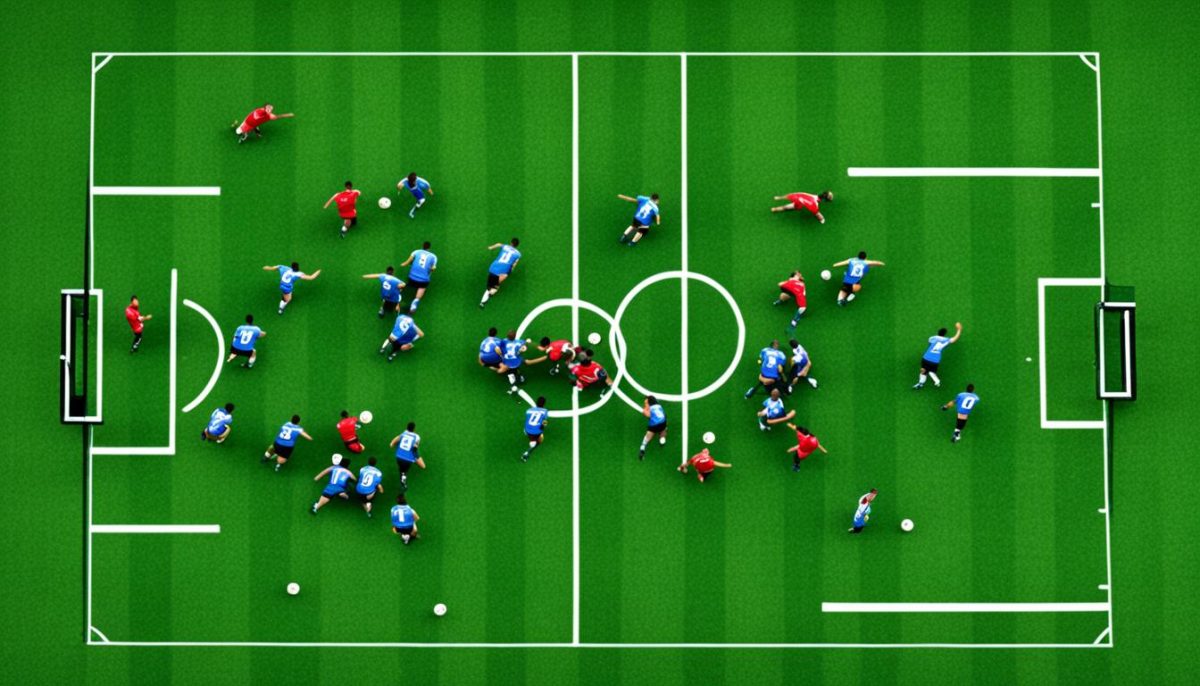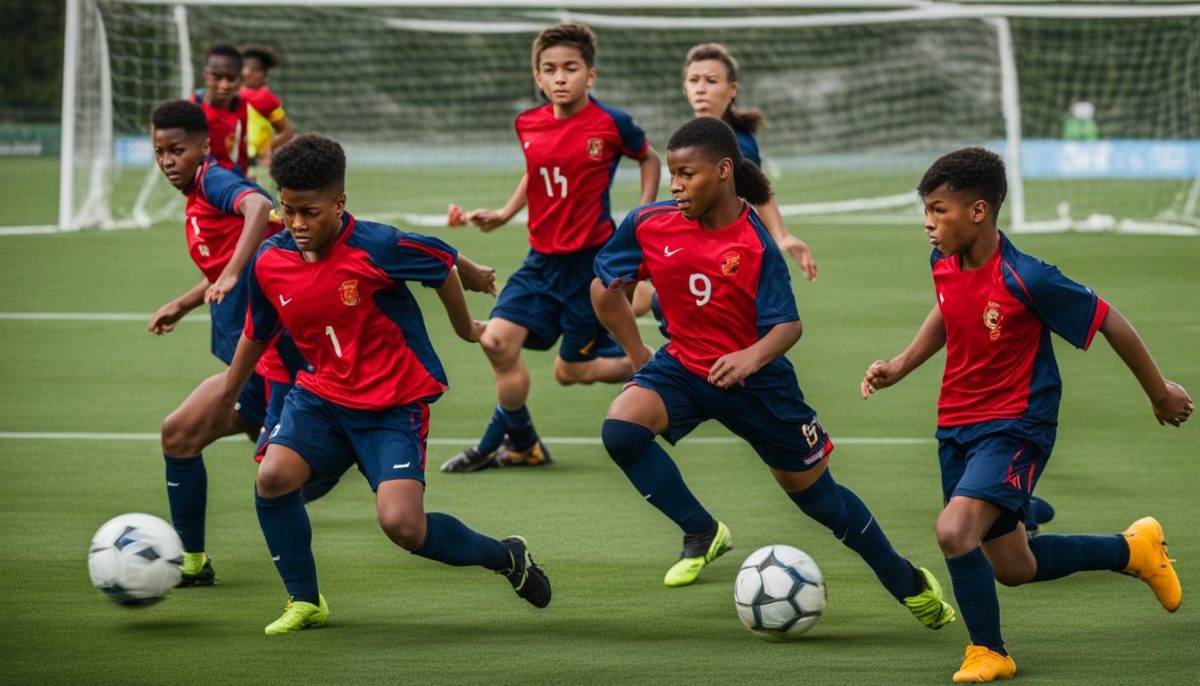Are you looking to take your soccer team to the next level? Want to outplay your opponents and dominate the game? It’s time to unlock the secrets of high pressing, an aggressive defensive strategy that can disrupt your opponent’s play and give your team the advantage.
But what exactly is high pressing? And how can you implement it effectively in your game plan?
In this comprehensive guide, we will dive deep into the world of high pressing, exploring six winning strategies that will revolutionize your team’s performance. From pressing tactics and drills to techniques used by the top professionals, we’ve got you covered.
To help you visualize the impact of high pressing, consider this: How would your team feel if they could consistently dominate possession, apply relentless pressure, and create turnover opportunities?
Ready to take your team’s game to the next level? Let’s get started and discover the powerful techniques that can elevate your soccer success.
Understanding Soccer Formations and Playing Systems
When it comes to implementing different tactics in soccer, understanding formations and playing systems is crucial. Formations refer to the organization of players on the field, while playing systems are the tactical strategies used during the game. By choosing the right formation and playing system, teams can effectively execute their game plan, including high pressing.
There are various formations available, each presenting its own advantages and considerations. Defensive formations, such as 5-4-1 and 4-5-1, prioritize a strong defensive structure and provide a solid foundation for implementing high pressing. Balanced formations like 4-4-2 and 4-3-3 offer a well-rounded approach, focusing on both defense and attack. On the other hand, attacking formations like 3-4-3 and 3-5-2 prioritize offensive prowess, enabling teams to maintain pressure on the opposing defense.
Each formation requires specific tactics and player roles to effectively apply high pressing. For instance, in a defensive formation, players need to be organized and compact to limit the opponent’s space and quickly transition into pressing when the ball is lost. In a balanced formation, players must maintain a balance between defensive duties and offensive contributions, maintaining pressure and disrupting the opponent’s build-up play. And in an attacking formation, players need to emphasize width and depth, exploiting spaces left by the opposition to create scoring opportunities through pressing.
Let’s take a closer look at three commonly used formations:
| Formation | Description | Tactics |
|---|---|---|
| 5-4-1 | A defensive formation that prioritizes a strong backline with limited attacking options. | – Tight man-to-man marking to deny space – Compactness to limit opponent’s chances – Quick counter-attacks with long balls |
| 4-4-2 | A balanced formation with four defenders, four midfielders, and two forwards. | – Pressing in midfield to disrupt opponent’s buildup – Wingers providing width and crosses into the box – Quick transitions from defense to attack |
| 3-4-3 | An attacking formation that emphasizes offensive firepower and increased goal-scoring opportunities. | – High pressing to force turnovers in the opponent’s half – Wingbacks providing width and overlapping runs – Fluid movement and rotation of front three for unpredictable attacking patterns |
Understanding the different formations and their associated tactics is essential for coaches and players looking to implement high pressing effectively. By analyzing the strengths and weaknesses of each formation, teams can adapt their playing systems to maximize their chances of success while maintaining a cohesive defensive and offensive strategy.
Tactics Associated with High Pressing
High pressing is a dynamic defensive strategy that requires specific tactics to disrupt the opponent’s build-up play and regain possession quickly. Depending on the chosen formation, teams can employ various strategies to execute high pressing effectively.
Defensive Formations:
One defensive tactic associated with high pressing is utilizing counter-attacks to exploit the spaces left open by the opponent’s aggressive positioning. This tactic involves the rapid transition from defense to offense, catching the opposition off guard and creating scoring opportunities in the process.
Another tactical approach is employing low pressing near the team’s own penalty area to limit space for the opposing team. By forming a compact defensive line in this area, the team can restrict the opponent’s ability to penetrate their defensive structure, forcing them to make hurried decisions and potentially commit errors.
The concept of compactness is crucial in high pressing. It involves players maintaining close proximity to one another and minimizing gaps between the defensive lines. This compactness ensures that passing lanes are blocked, reducing the options for the opposing team and increasing the chances of regaining possession.
Balanced Formations:
In balanced formations, high pressing is often associated with a focus on possession and ball control. This tactic allows the team to dictate the tempo of the game, retaining the ball while patiently waiting for opportunities to exploit the opponent’s defensive vulnerabilities.
Fast transition play is another tactic commonly used in balanced formations. It emphasizes quick and efficient ball circulation, enabling the team to rapidly shift from defense to attack and catch the opposition off guard during their moments of disorganization.
Additionally, implementing midfield pressing is advantageous in balanced formations. By pressing the opposition’s midfielders, the team can disrupt their rhythm and limit their ability to create chances, ultimately regaining possession and launching their own attacks.
Attacking Formations:
In attacking formations, high pressing is combined with strategies that aim to utilize the entire width and depth of the field. This tactic ensures that the opposition is constantly under pressure, with the attacking team quickly closing down spaces and limiting their options.
Player rotation and movement play a crucial role in attacking formations. By continuously interchanging positions and making intelligent off-the-ball runs, attackers can confuse defenders and create openings for their teammates to exploit.
To maximize the effectiveness of high pressing, teams employing attacking formations prioritize width and depth. This strategy stretches the opposition’s defense, creating spaces for the attackers to exploit and increasing the chances of creating scoring opportunities.

| Tactics Associated with High Pressing | Defensive Formations | Balanced Formations | Attacking Formations |
|---|---|---|---|
| Counter-attacks | Low pressing | Possession and ball control | Width and depth |
| Compactness | Fast transition play | Player rotation and movement | |
| Midfield pressing |
Adaptability and Tactical Flexibility
Adaptability and tactical flexibility are essential attributes for achieving success in soccer. In order to effectively navigate the dynamic nature of the game, both coaches and players must possess the ability to adapt their formations, tactics, and player roles based on the specific circumstances of each match.
Adaptability encompasses the capacity to respond to different playing styles employed by the opposition. By understanding and adjusting to the unique strengths and weaknesses of the opponent, teams can strategically plan their game approach and neutralize their tactics effectively.
Tactical flexibility, on the other hand, involves the willingness to change formations and tactics throughout the game. Coaches must be prepared to alter their team’s formation to suit the flow of the match or exploit an opponent’s vulnerabilities. This might involve transitioning from a defensive formation to an attacking formation to apply more pressure and create scoring opportunities.
Another aspect of tactical flexibility is the ability to adapt player roles during a game. Coaches may need to shift players to different positions or modify their responsibilities on the field to address specific situations. This fluidity enables teams to optimize their performance and adapt to the changing dynamics of the game.
Dealing with different playing styles requires strategic planning and coordination. Through effective communication on the field, teams can quickly adjust their tactics and formations to counter the opponent’s strategies. This coordinated effort ensures that all players are on the same page and can seamlessly transition between various tactical approaches.
“Adaptability and tactical flexibility are crucial elements for achieving success in soccer. We must adapt our formations and tactics to match the specific circumstances of each match and effectively neutralize the opponent’s playing style.” – Coach Alex Ferguson
In summary, in the ever-changing world of soccer, adaptability and tactical flexibility play a significant role in determining a team’s success. The ability to change formations, tactics, and player roles, as well as effectively deal with different playing styles, requires strategic planning, communication, and coordination. By embracing these qualities, teams increase their chances of victory and demonstrate their ability to excel in any situation.
Key Points:
- Adaptability and tactical flexibility are crucial for success in soccer.
- Teams must adapt formations, tactics, and player roles based on match circumstances.
- Responding to different playing styles requires strategic planning and coordination on the field.
- Changing formations and tactics throughout the game can neutralize the opponent’s strategies.
- Effective communication and coordination ensure seamless transitions between tactical approaches.

Offensive and Defensive Strategies
In addition to high pressing, coaches need to consider both offensive and defensive strategies. These strategies play a crucial role in a team’s overall performance and can greatly impact the outcome of a game. Let’s explore two key tactics: possession play and counter-attacking.
Possession Play
Possession play is a fundamental strategy in soccer that focuses on controlling the ball and maintaining possession for extended periods. Teams utilizing possession play aim to dominate the game by meticulously circulating the ball, patiently waiting for gaps in the opponent’s defense to exploit.
By successfully executing possession play, teams can dictate the tempo of the match, unsettle the opposition, and create scoring opportunities. This tactic requires exceptional technical skills, teamwork, and communication.
Counter-Attacking
Counter-attacking is a fast and decisive strategy employed by teams looking to exploit their opponent’s vulnerability during a transition from defense to offense. This tactic involves swiftly launching attacks and capitalizing on the spaces left behind by the opposing team’s forward movements.
Teams that excel in counter-attacking possess players with speed, agility, and exceptional decision-making abilities. By quickly transitioning from defense to offense, they catch the opposition off guard and create dangerous scoring chances.
Defensive Strategies
While offensive strategies are essential for scoring goals, a solid defense is equally crucial for preventing goals. In soccer, two commonly used defensive strategies are man-to-man marking and zone defense.
Man-to-man marking assigns each defender the responsibility of closely tracking and marking an opposing player throughout the game. This tactic aims to deny the opponent any time and space to execute their attacking moves, making it difficult for them to penetrate the defense.
Zone defense, on the other hand, focuses on assigning defenders to specific areas of the field. Each defender guards a specific zone and is responsible for any opposing player who enters that zone. This strategy enhances teamwork, communication, and coordination among defenders to effectively cover all areas of the field.
Both man-to-man marking and zone defense require a strong understanding of defensive positioning, communication, and the ability to read the game.
Understanding and utilizing offensive and defensive strategies, such as possession play, counter-attacking, man-to-man marking, and zone defense, can significantly enhance a team’s chances of success. Coaches and players should analyze their team’s strengths and weaknesses to determine the most suitable strategies to implement in different game scenarios.
Set Pieces and Tactical Approaches
Set pieces, including corner kicks, free kicks, and penalty kicks, present strategic opportunities for teams to score goals and gain an advantage over their opponents. Coaches can employ various tactics and approaches to maximize the effectiveness of these set pieces and increase the likelihood of finding the back of the net.
One effective tactic during corner kicks is to position players near the goalkeeper. This strategic placement creates distractions for the opposition and opens up space for other players to make runs and attempt shots on goal. By drawing the attention of defenders towards the crowded area near the goalkeeper, the attacking team creates opportunities for unmarked players to be in advantageous positions to receive crosses or loose balls.
When it comes to free kicks, incorporating fake shots or passes can be a valuable tactic to confuse the opposing team and create scoring chances. By making the defenders uncertain about the intended action, the attacking team gains an element of surprise and can exploit any gaps in the defensive wall or the positioning of the goalkeeper. Utilizing deceptive movements and passing options, the attacking team can create openings for shots on goal or well-executed set-piece routines.
Understanding and practicing these tactical approaches can give a team a significant advantage in set piece situations. By capitalizing on these opportunities, teams can enhance their offensive prowess and increase their chances of scoring goals, ultimately impacting the outcome of matches.
Tactical Approaches for Set Pieces
| Set Piece Type | Tactical Approach |
|---|---|
| Corner Kick | Position players near the goalkeeper to create distractions and open up space for other attackers. |
| Free Kick | Incorporate fake shots or passes to confuse the opposition and create scoring opportunities. |
| Penalty Kick | Vary shot placement and use deceptive movements to outwit the goalkeeper and increase the chances of scoring. |
By employing these tactical approaches during set pieces, teams can optimize their scoring potential and gain an edge over their opponents.
Making Tactical Decisions: Substitutions and Formations
As a coach, making tactical decisions is an essential aspect of our role in guiding our team to success. Two key elements that require careful consideration are substitutions and formations. Substitutions should be timed strategically, taking into account the team’s needs and the fitness levels of our players. By making substitutions at the right moment, we can inject fresh energy and skills into the game.
Furthermore, formations play a crucial role in shaping our team’s tactics and gameplay. Adjusting our formations based on the game situation allows us to emphasize specific strategies and exploit our opponents’ weaknesses. It is vital for us, as coaches, to understand the strengths and weaknesses of different formations and utilize them strategically to our advantage.
When determining substitutions and formations, several factors come into play. Firstly, player fitness is of utmost importance. We must carefully assess the physical condition of our players and make changes accordingly, ensuring they are performing at their best and minimizing the risk of injuries. Additionally, man-to-man marking and zone defense are tactical considerations that impact both substitutions and formations. These defensive strategies affect how we allocate players on the field and target our opponents.
Ultimately, making tactical decisions rests on our shoulders as coaches. Each decision we make, whether it’s a substitution or a formation adjustment, has the potential to greatly influence the outcome of the game. By analyzing the game situation and implementing strategic decisions, we can lead our team to triumph and achieve our goals.






